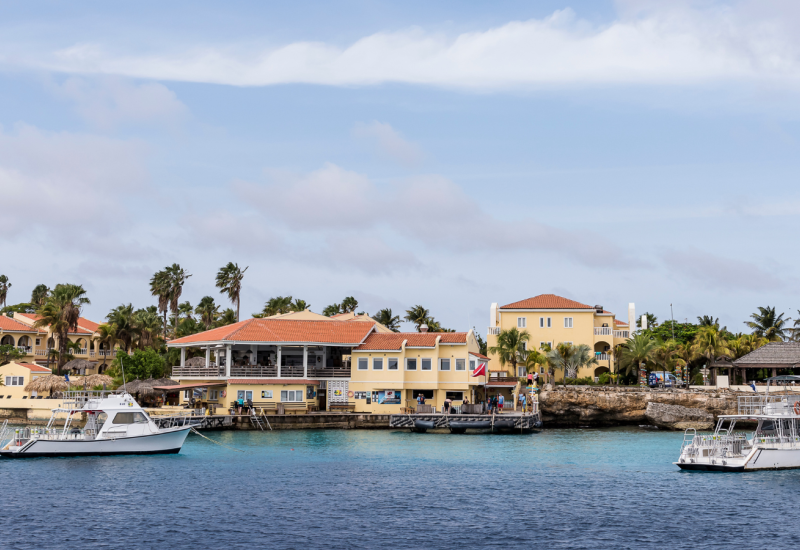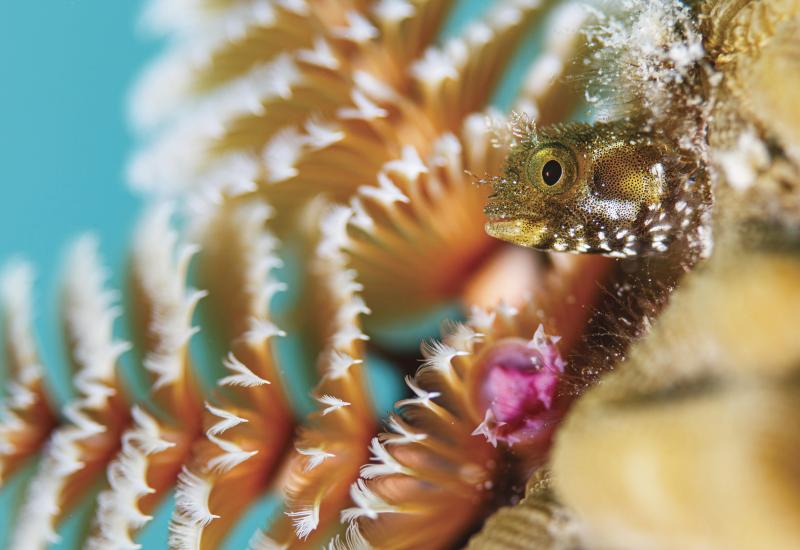Diving Bonaire 24/7

Night Diving
You're the divemaster when you shore dive on Bonaire.
Steve Simonsen
By Robert Osborne
Photography by Steve Simonsen
The fun at Oil Slick Leap starts with the entry. The moderately brave can giant stride off the 10-foot cliff, but don't worry, there's also a ladder. I check out the drop, and the knot in my stomach makes me feel like a kid again. With one deep breath, I close my eyes and make the leap into 20 feet of water.
This kind of easy shore diving is what makes Bonaire special. Just 10 minutes earlier, I decided on a dive site, grabbed a couple of tanks from the dive shop, loaded my gear into a rental pickup, and headed north up the coastal road. After a quick suiting-up at the site, I'm in the water, just one of a few divers here this early. Oil Slick, like most of the island's northern ones, starts from shore with a gradually deepening plain that drops off into a steep slope about 100 yards out. Finning along at the 60-foot level, castle-like stacks of sheet and pillar corals swell to heights of more than 30 feet and thousands of colorful reef fish flit about. And just before ascending the ladder, I explore a couple of caves underneath it, where massive porcupinefish have taken up residence.
Bonaire — the "B" in the Netherlands Antilles "ABC islands" — is legendary for shore dives. This site and 60 others up and down the island's west coast, north and south of the island's centrally located capital, Kralendijk, are remarkably accessible, thanks to an infrastructure borne of a long tradition of conservation that gives divers the freedom to plunge in practically anytime, anywhere. There's a cross section of walls and spur-and-groove reefs, with almost all the life sitting in less than 60 feet of water. The west coast shore dives are a short surface swim away and are easily reachable by car or truck. Rental pickup trucks come standard with tank racks, and most resorts have convenient stations for picking up and dropping off tanks. Hotel rooms come stocked with well-marked dive site maps and when you're driving to the sites, look for small, yellow-painted rocks denoting their locations. There's also diving off Klein Bonaire, a small island only a mile off the west coast, and at another half dozen sites off Bonaire's "Wild East Side." If you're feeling a little lazy and don't want to take the wheel or get aboard a boat, no sweat. You can fall into the water from the dock at your resort, where there are exceptional house reefs.
During my week here, I bounce up, down and around the island, rolling in a rented rig to shore dive, saddling up for boat dives and just dropping in from a dock, to indulge in unparalleled diving freedom.
North of Kralendijk
The road here is steep, with more dramatic cliffs the farther north you drive. Mind the road, as it narrows and eventually becomes one-way. The famed 1,000 Steps is a great introduction to diving this part of Bonaire's west coast. Although the name suggests something strenuous, the entry here involves descending roughly 65 or 70 steps, quite manageable by divers in even moderate shape. After hauling my gear down to the beach and submerging, I'm rewarded by an impressive display of large brain coral, a number of massive grouper and a healthy-sized rainbow parrotfish.
A few other northern sites — Rappel, Bloodlet and Country Garden — can only be accessed by boat, as the coastal road swings inland here because of steep cliffs. If your dive resort's boat heads up here, get on board — the sites are well worth it. Rappel has an unusually wide and deep plateau that extends from the base of the cliffs on shore to the drop-off. It's the plateau that's worth a second look. Hard and soft corals thrive right up to the base of the cliff. The sun penetrates into the shallow water, dappling the coral with almost impressionistic splashes of light. With schools of brilliantly colored tropical fish swirling around, it feels as if I'm swimming in a saltwater aquarium. Take advantage of that great light penetration to look for the tiniest creatures on the reef — cleaner shrimp and even slender filefish.
South of Kralendijk
On the drive south from Kralendijk the terrain is flatter and more beachy. Angel City is a classic example of southern Bonaire's double reef system, where a short swim across a sand channel takes you from one reef to another. Angel City consists of an inshore reef in about 30 feet of water with a second reef in about 60 to 80 feet of water. The two reefs are separated by about 40 to 60 feet of sand. Typically, divers descend on the outer reef after entry, swim against the current and then at the turnaround point, swim over to the inner reef and return to the entry point. Keep an eye open on the sandy stretches for stingrays and the occasional spotted eagle ray.
The wreck of the Hilma Hooker is another must-do southern site. She's a 236-foot-long freighter with a colorful history of illegal drug running. In 1984, she was intentionally sunk as an artificial reef. The stately ship — which is dived both from shore and boat — rests on her starboard side in 90 feet of water, making her one of Bonaire's deepest dives. From the shore you reach the wreck by descending down a beautiful slope of coral. Clear water allows me to take in the entire length of the wreck, which seems to stretch out forever and tower overhead. I have time for a quick look inside both of the Hooker's cargo holds, while also watching out for schools of tarpon.
Invisibles, also on the southwest coast, is arguably the island's healthiest stretch of reef. Large sea fans and plumes crowd the shallower sections of the reef. And it's common to see spotted eagle rays feeding in the sand on the way out. I watch one digging for a meal of sand eels for several minutes.
Klein Bonaire
The only way to dive Klein Bonaire, Bonaire's satellite island, is by boat. Most resorts offer morning or afternoon trips. Our first dive, at a site called Sampler, is a bit surreal. Halfway through the dive, I look up the coral slope toward the light, and the unlikely image of the Arizona desert comes to mind, with tube sponges replacing cactus, sea plumes filling in for tumbleweed and coral heads substituting for granite hillsides. True to its name, Sampler offers a variety of marine life — seahorses, massive turtles, delicate goldenspotted eels and massive schools of reef fish.
Knife is also a special site. It was reopened after being closed for a decade by the Bonaire National Parks Foundation to give the site a chance to recover from diving pressure. The rest has done the reef a lot of good, as its soft corals and tube sponges are in excellent shape, attracting thousands of juvenile fish, which surround me throughout the dive. Keep one eye on the open-water side of the dive, as manta rays, dolphins and sharks come in from the blue from time to time and turtle sightings are a regular occurrence.
At another recently reopened site here, Keepsake Reef, I can see the positive impact of the closure, as seahorses, goldenspotted eels, porcupinefish and French angelfish have returned, highlighting the usual selection of grunts and jacks.
Klein Bonaire also features a couple of nice drift dives off its eastern corner. At a site called Forest, we spend 50 minutes letting a current gently push us over to Southwest Corner, an adjacent site. We see turtles and some nice size barracuda along the way, but others report regular sightings of eagle rays and even the occasional dolphin.
The Wild Side
Until about 10 years ago, this area was virtually ignored by dive operators and divers because of a constant southeasterly wind blowing in, creating massive waves. Then, entrepreneur Larry Baillie bought a solid-hulled zodiac that could handle any waves the east side could create and opened Larry's Wildside Diving, still the area's only dive operation. The zodiac departs from a fishing dock on Bonaire's east side, about a 15-minute drive from Kralendijk. The adrenaline rush of riding the boat through the whitecaps is only the start of the thrills. That's because on our first dive, at Larry's Reef, we see eight large turtles and a half dozen large stingrays. Twice, like some kind of choreographed dance, the turtles swim by in the foreground, while the rays cross from the other direction.
Finally, we try out the White Hole. We make our way to what seems to be a large underwater amphitheater and swim to its far side, where more than a dozen large tarpon lazily swim about. If you hang in the water and let the gentle surge carry you, you'll get within a few feet of these seemingly plate mail-clad, medieval-looking fish. We also see several large green morays. But the most memorable moment comes as we pass one section of the reef where a school of thousands of blue chromis surges in and out. The small fish are swarming around the reef the way ants might after someone kicked over an anthill. Toward the end of the dive, a piece of seaweed that seems to have a little more control of its direction in the swell than others, comes into view. A closer look reveals a tiny seaweed blenny doing what it does best — blending into the scenery.
While this east-side dive experience is decidedly different from the rest of Bonaire diving, it's a testament to just how diverse the island's underwater offerings are. There's surprising variety from both the shore and from dive boats, but still, that's not the best part of Bonaire diving. It's being able to get up each morning and custom design your own diving experience. That's true diving freedom.
A Model of Conservation: Bonaire National Marine Park
Bonaire's reefs are so healthy that countries around the globe try to emulate the island's conservation model, which started in the 1960s and encompasses all the waters around it and Klein Bonaire.
No matter how experienced or careful a diver you may be, you're legally bound to first earn it before setting fin in the water. STINAPA Bonaire, the foundation that oversees the marine park, requires every diver and snorkeler to complete an orientation session, that covers underwater rules and regulations. That also means making a checkout dive, supervised by a dive guide, ensuring that you're properly weighted and have good buoyancy skills. After checkout, you then purchase a marine park admission tag for $25. Here's the good news: All dive resorts and dive shops offer the orientations, checkouts and admission tags. Here's better news: The tags are good for a calendar year.
Recently, the Coral Restoration Foundation has been working in Bonaire to continue the island's legacy of conservation .
Diving The Town Pier
This site is considered one of the Caribbean's best night dives, and it doesn't take long to see why. Underneath this dock, brilliant golden cup corals and delicate purple tube sponges appear to be valiantly struggling to grow and cover unsightly mounds of industrial debris. Seahorses are hiding in the rubber tires and wreckage, hanging by their tails and camouflaging themselves as other pieces of debris. Massive pylons sprout from the ocean floor and shoot upward into the darkness, where canary yellow frogfish inhabit lofty perches. Spotted and golden-tailed moray eels have taken up residence in broken bits of concrete blocks. Despite its incongruous appearance, the Pier actually boasts a very healthy section of reef and abundant fish. But before you truck on down there, you must book this shore dive through your resort's dive shop at least 24 hours in advance (the shop must first get clearance from the harbor master) and be escorted at the site by a local dive guide.
Kralendijk: Bonaire's Charming Capital
Though it's hard to break away from the diving, it's worth paying a couple of visits to Kralendijk, Bonaire's capital. The town's heart takes up about three blocks and boasts historical buildings, a lovely waterfront boulevard, nice shopping and terrific restaurants and bars. To get started, pick up a free walking map of the town at the tourist office, on the corner of the main streets at Kaya Grandi 2 (tourismbonaire.com).
Kralendijk (pronounced Kraal-en-dike) is where Holland meets the Caribbean. The architecture — check out the Customs House and Old Fort close to Town Pier — is distinctly colonial Dutch overlaid with bright pastel colors for a true island flavor. Just walking along the main streets and browsing in the shops is a pleasant way to spend a morning or afternoon. With little car traffic, the whole town is pedestrian-friendly, and you can walk across it in about 20 minutes.
Name a cuisine and you'll probably find it in Kralendijk at one of its numerous restaurants and sidewalk cafes. You'll find places that feature traditional Caribbean dishes, but you can also sample Middle Eastern, Indonesian, Chinese, Mexican, French and Italian fare. For a complete list, check out infobonaire.com/restaurant.html.
Sunset is a great time to hit Kralendijk's waterfront at places like Karel's Beach Bar, which is built on a pier over the water, or City Cafe, located on the waterfront boulevard in the center of town. Both places really start to jump about 10 p.m., with music during the week and live bands on the weekend.
Off-gassing Options
Take a guided tour of Lac Bay, through the mangrove swamps. Pack a mask and snorkel and your guide can point out a nice swim-through tunnel under the mangrove trees. But watch where you step — scorpionfish do their best to look like rocks on the bottom.
Go "land sailing" in a three-wheeled, one-person aluminum cart, equipped with a sail and powered by wind. You use a hand-held rudder and rope to move your front wheel and maneuver fast or slow along a figure-eight track. After getting the hang of it, you can tear around the track at 30 mph, but it'll seem a lot faster.
landsailingbonaire.com
Guides lead small groups into the flooded limestone catacombs that riddle the island. Take a mask, snorkel and dive light. No technical expertise is required, and many resorts arrange trips for their guests.
Our Thanks
Buddy Dive Resort (buddydive.com) for hosting our team's stay.
InDepth
Dive Conditions: Water temps are in the mid-70s in winter; 80s in summer. Vis averages 50 to 60 feet.
Weather: 80s in winter; 90s in summer.
Money Matters: Currency is the Netherlands Antilles guilder (ANG), fixed at the exchange rate of 1.77 to the dollar for cash. You'll have to purchase a $25 marine park tag before you dive.
Tourism: Tourism Corporation Bonaire
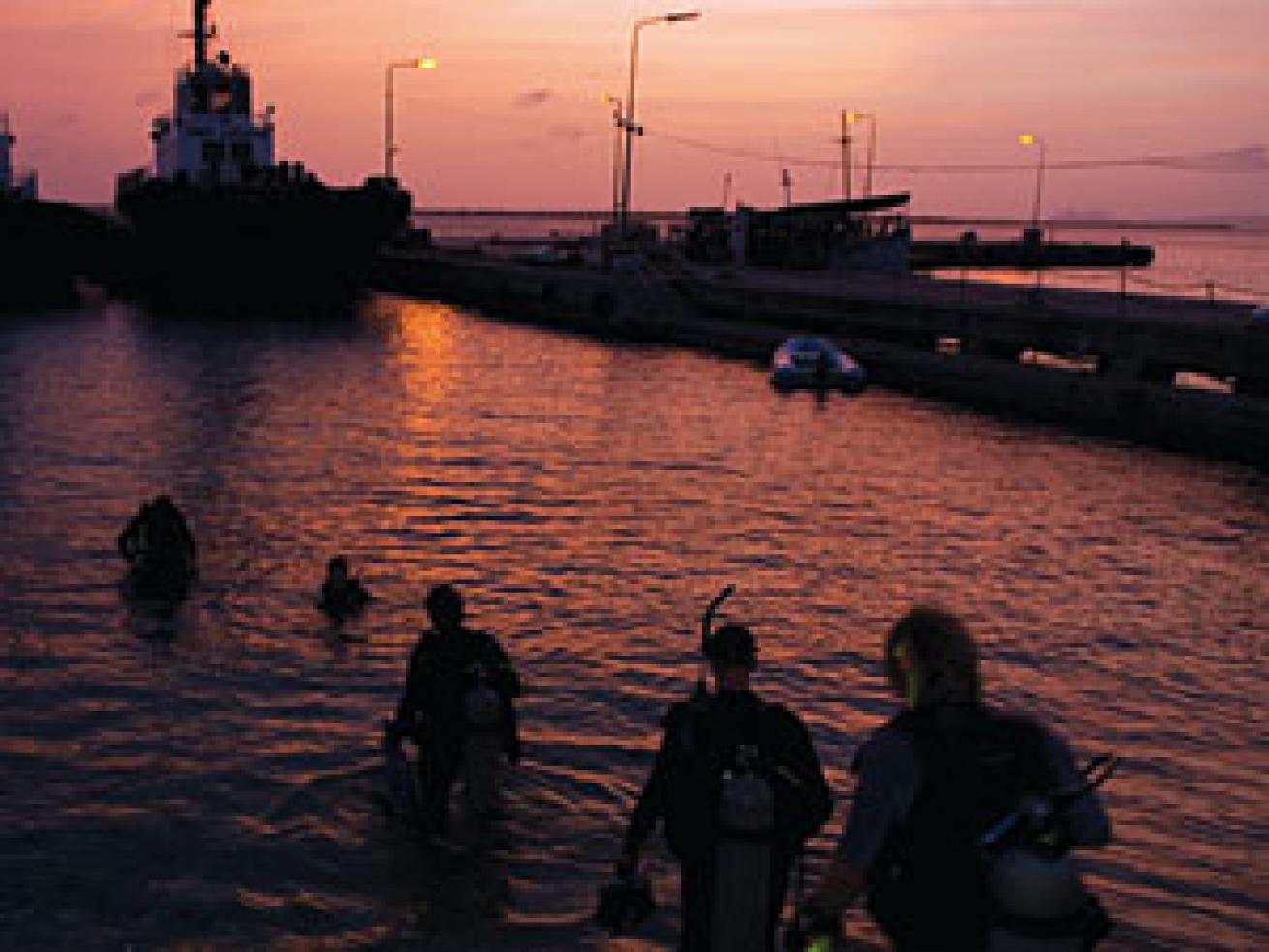
Steve SimonsenYou're the divemaster when you shore dive on Bonaire.
By Robert Osborne
Photography by Steve Simonsen
The fun at Oil Slick Leap starts with the entry. The moderately brave can giant stride off the 10-foot cliff, but don't worry, there's also a ladder. I check out the drop, and the knot in my stomach makes me feel like a kid again. With one deep breath, I close my eyes and make the leap into 20 feet of water.
This kind of easy shore diving is what makes Bonaire special. Just 10 minutes earlier, I decided on a dive site, grabbed a couple of tanks from the dive shop, loaded my gear into a rental pickup, and headed north up the coastal road. After a quick suiting-up at the site, I'm in the water, just one of a few divers here this early. Oil Slick, like most of the island's northern ones, starts from shore with a gradually deepening plain that drops off into a steep slope about 100 yards out. Finning along at the 60-foot level, castle-like stacks of sheet and pillar corals swell to heights of more than 30 feet and thousands of colorful reef fish flit about. And just before ascending the ladder, I explore a couple of caves underneath it, where massive porcupinefish have taken up residence.

Steve SimonsenYou're the divemaster when you shore dive on Bonaire.
Bonaire — the "B" in the Netherlands Antilles "ABC islands" — is legendary for shore dives. This site and 60 others up and down the island's west coast, north and south of the island's centrally located capital, Kralendijk, are remarkably accessible, thanks to an infrastructure borne of a long tradition of conservation that gives divers the freedom to plunge in practically anytime, anywhere. There's a cross section of walls and spur-and-groove reefs, with almost all the life sitting in less than 60 feet of water. The west coast shore dives are a short surface swim away and are easily reachable by car or truck. Rental pickup trucks come standard with tank racks, and most resorts have convenient stations for picking up and dropping off tanks. Hotel rooms come stocked with well-marked dive site maps and when you're driving to the sites, look for small, yellow-painted rocks denoting their locations. There's also diving off Klein Bonaire, a small island only a mile off the west coast, and at another half dozen sites off Bonaire's "Wild East Side." If you're feeling a little lazy and don't want to take the wheel or get aboard a boat, no sweat. You can fall into the water from the dock at your resort, where there are exceptional house reefs.
During my week here, I bounce up, down and around the island, rolling in a rented rig to shore dive, saddling up for boat dives and just dropping in from a dock, to indulge in unparalleled diving freedom.
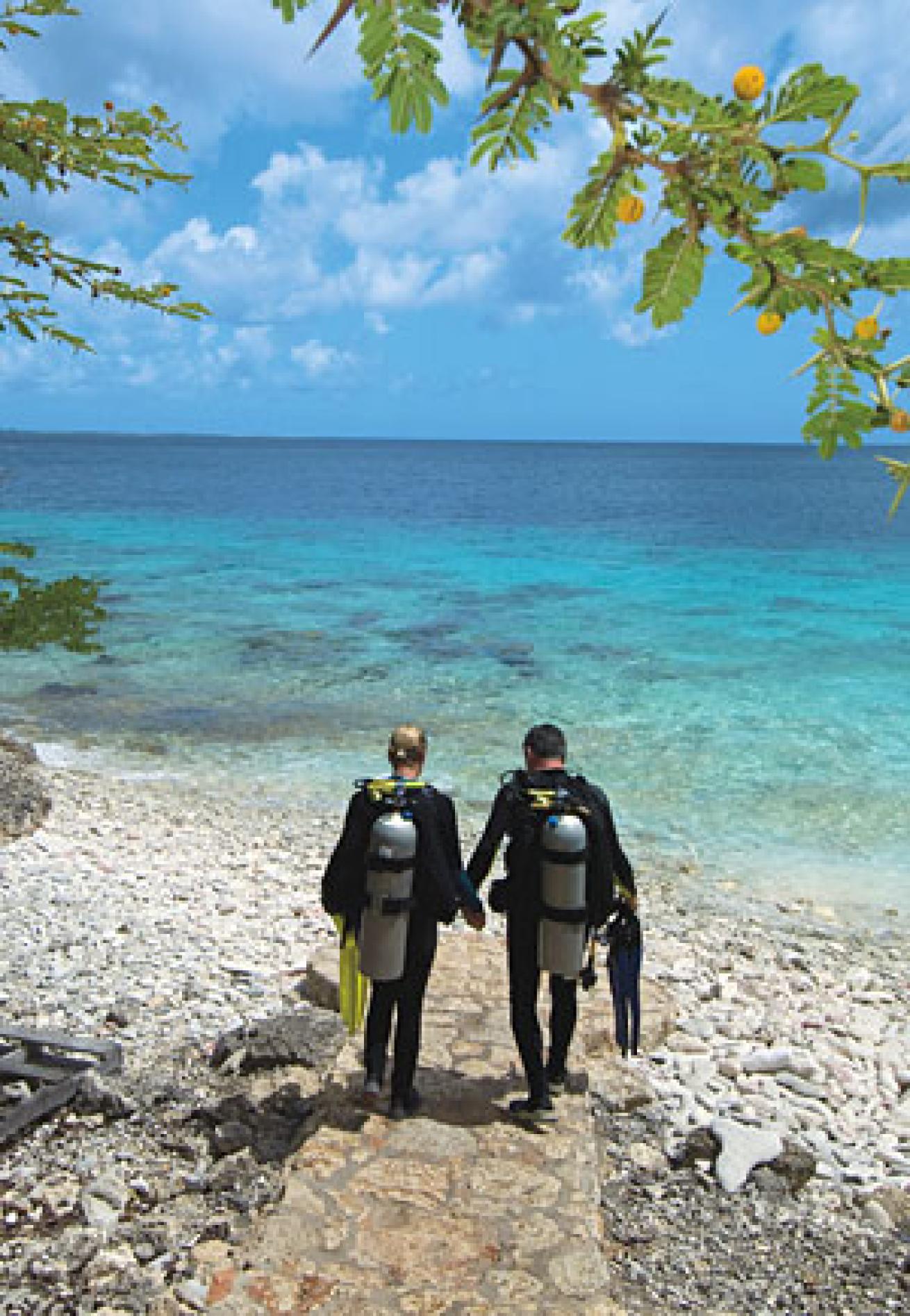
Steve SimonsenWith so many dive sites to choose from, you can often be the only divers in the water.
North of Kralendijk
The road here is steep, with more dramatic cliffs the farther north you drive. Mind the road, as it narrows and eventually becomes one-way. The famed 1,000 Steps is a great introduction to diving this part of Bonaire's west coast. Although the name suggests something strenuous, the entry here involves descending roughly 65 or 70 steps, quite manageable by divers in even moderate shape. After hauling my gear down to the beach and submerging, I'm rewarded by an impressive display of large brain coral, a number of massive grouper and a healthy-sized rainbow parrotfish.
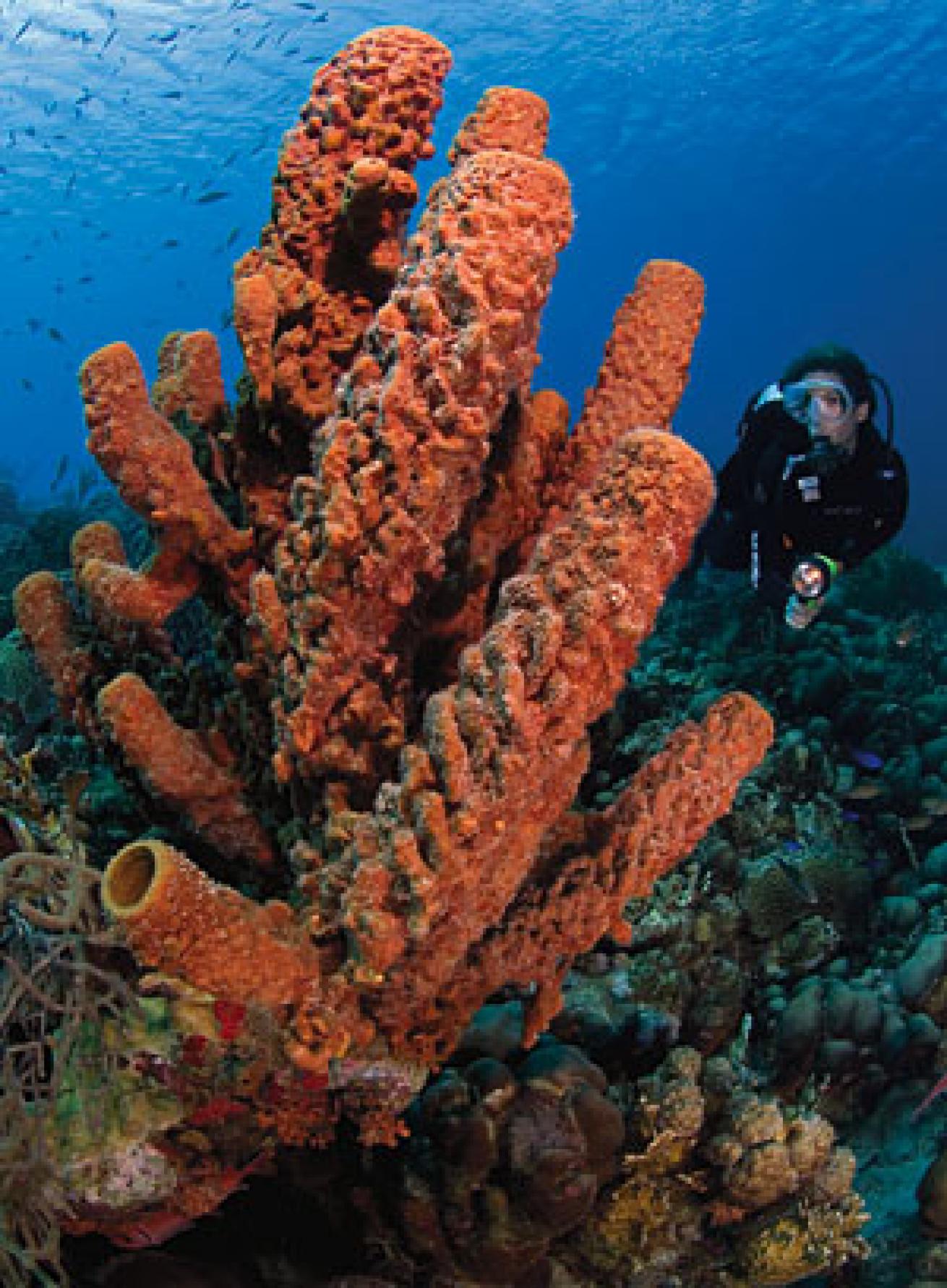
Steve SimonsenBonaire's reefs are known for their healthy sponges.
A few other northern sites — Rappel, Bloodlet and Country Garden — can only be accessed by boat, as the coastal road swings inland here because of steep cliffs. If your dive resort's boat heads up here, get on board — the sites are well worth it. Rappel has an unusually wide and deep plateau that extends from the base of the cliffs on shore to the drop-off. It's the plateau that's worth a second look. Hard and soft corals thrive right up to the base of the cliff. The sun penetrates into the shallow water, dappling the coral with almost impressionistic splashes of light. With schools of brilliantly colored tropical fish swirling around, it feels as if I'm swimming in a saltwater aquarium. Take advantage of that great light penetration to look for the tiniest creatures on the reef — cleaner shrimp and even slender filefish.
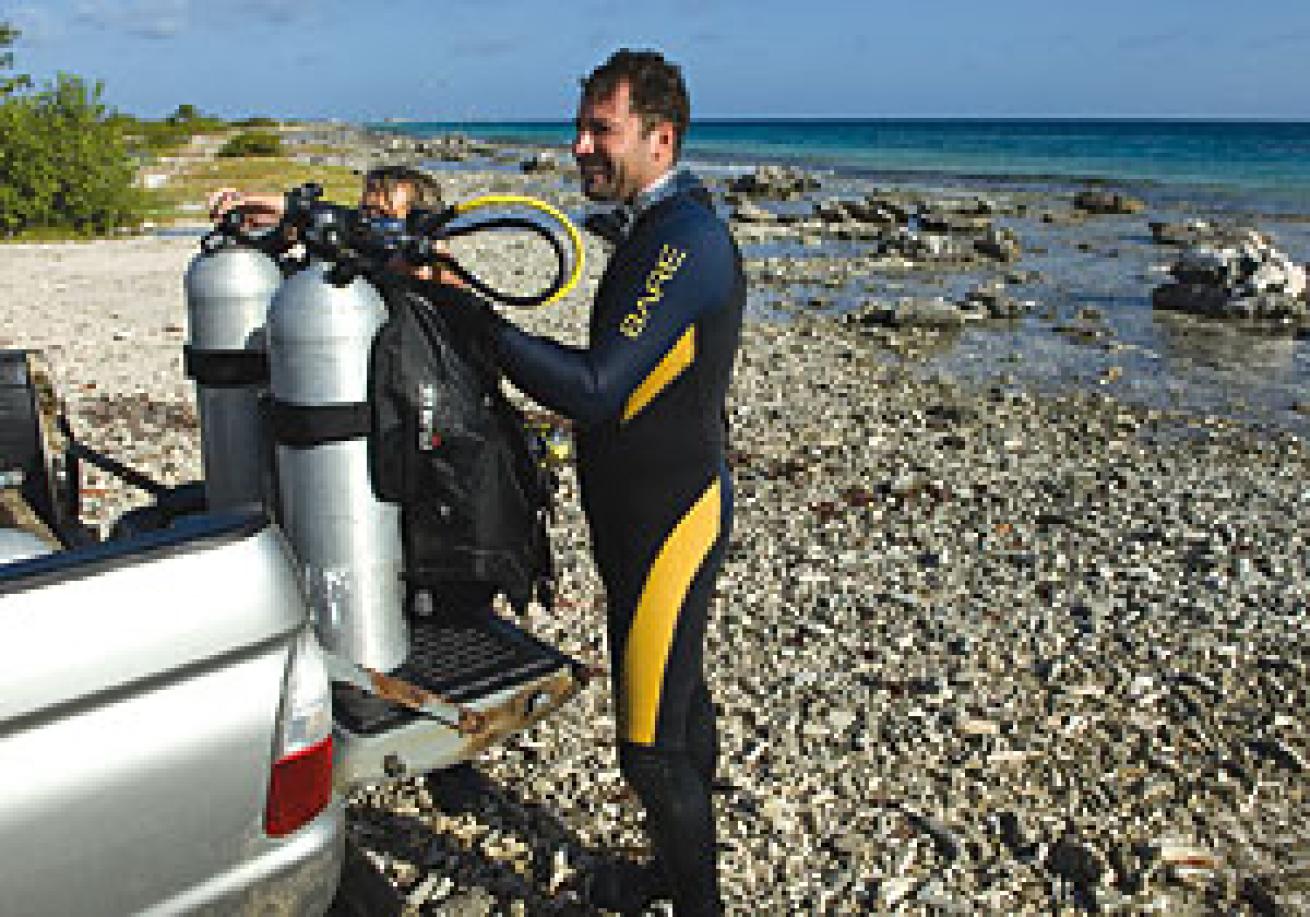
Steve SimonsenIt's easy to find Bonaire's dozens of sites — just look for the painted yellow stone marking each one, park your rental vehicle, and gear up.
South of Kralendijk
On the drive south from Kralendijk the terrain is flatter and more beachy. Angel City is a classic example of southern Bonaire's double reef system, where a short swim across a sand channel takes you from one reef to another. Angel City consists of an inshore reef in about 30 feet of water with a second reef in about 60 to 80 feet of water. The two reefs are separated by about 40 to 60 feet of sand. Typically, divers descend on the outer reef after entry, swim against the current and then at the turnaround point, swim over to the inner reef and return to the entry point. Keep an eye open on the sandy stretches for stingrays and the occasional spotted eagle ray.
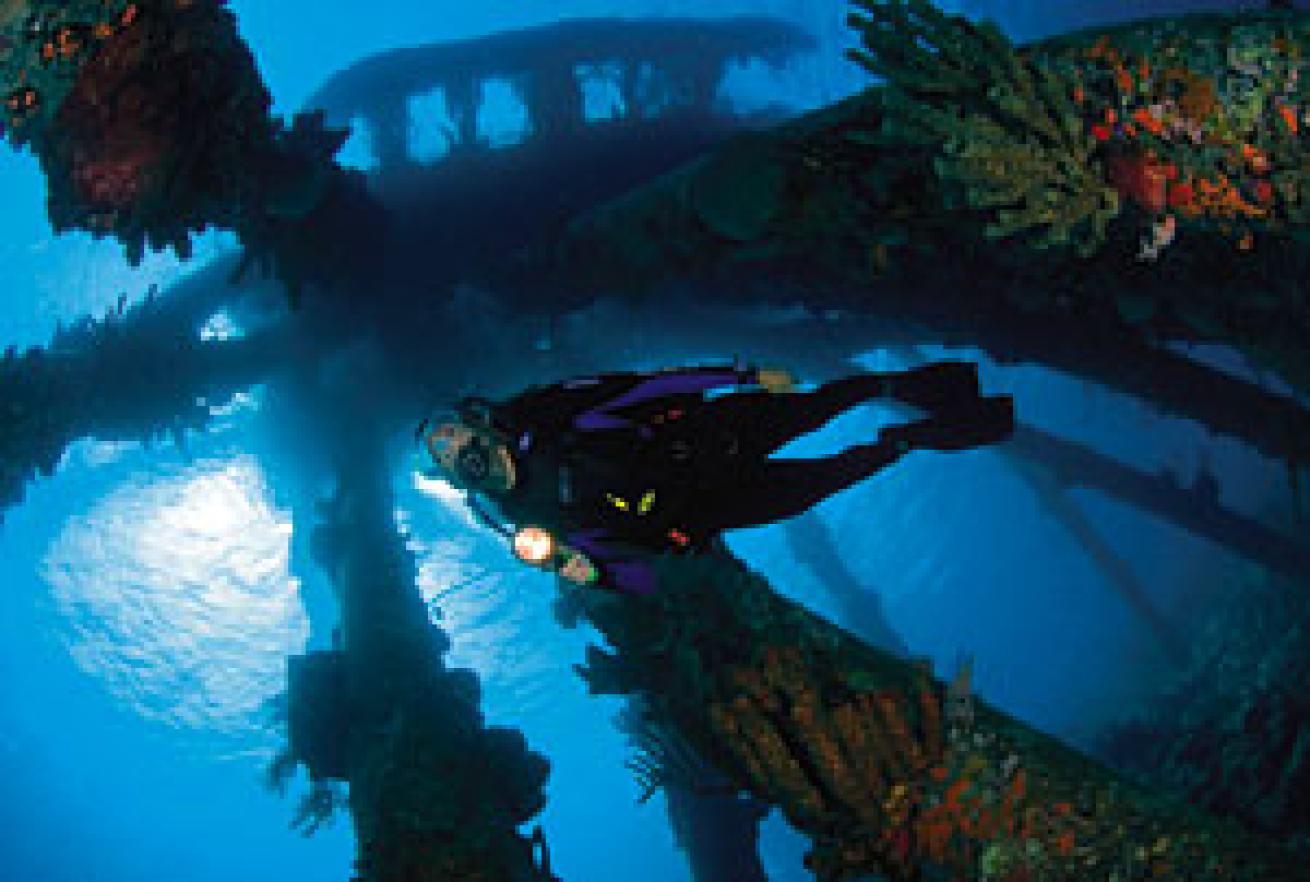
Steve SimonsenDivers can no longer dive Town Pier, but it is possible to dive Salt Pier (with permission).
The wreck of the Hilma Hooker is another must-do southern site. She's a 236-foot-long freighter with a colorful history of illegal drug running. In 1984, she was intentionally sunk as an artificial reef. The stately ship — which is dived both from shore and boat — rests on her starboard side in 90 feet of water, making her one of Bonaire's deepest dives. From the shore you reach the wreck by descending down a beautiful slope of coral. Clear water allows me to take in the entire length of the wreck, which seems to stretch out forever and tower overhead. I have time for a quick look inside both of the Hooker's cargo holds, while also watching out for schools of tarpon.
Invisibles, also on the southwest coast, is arguably the island's healthiest stretch of reef. Large sea fans and plumes crowd the shallower sections of the reef. And it's common to see spotted eagle rays feeding in the sand on the way out. I watch one digging for a meal of sand eels for several minutes.
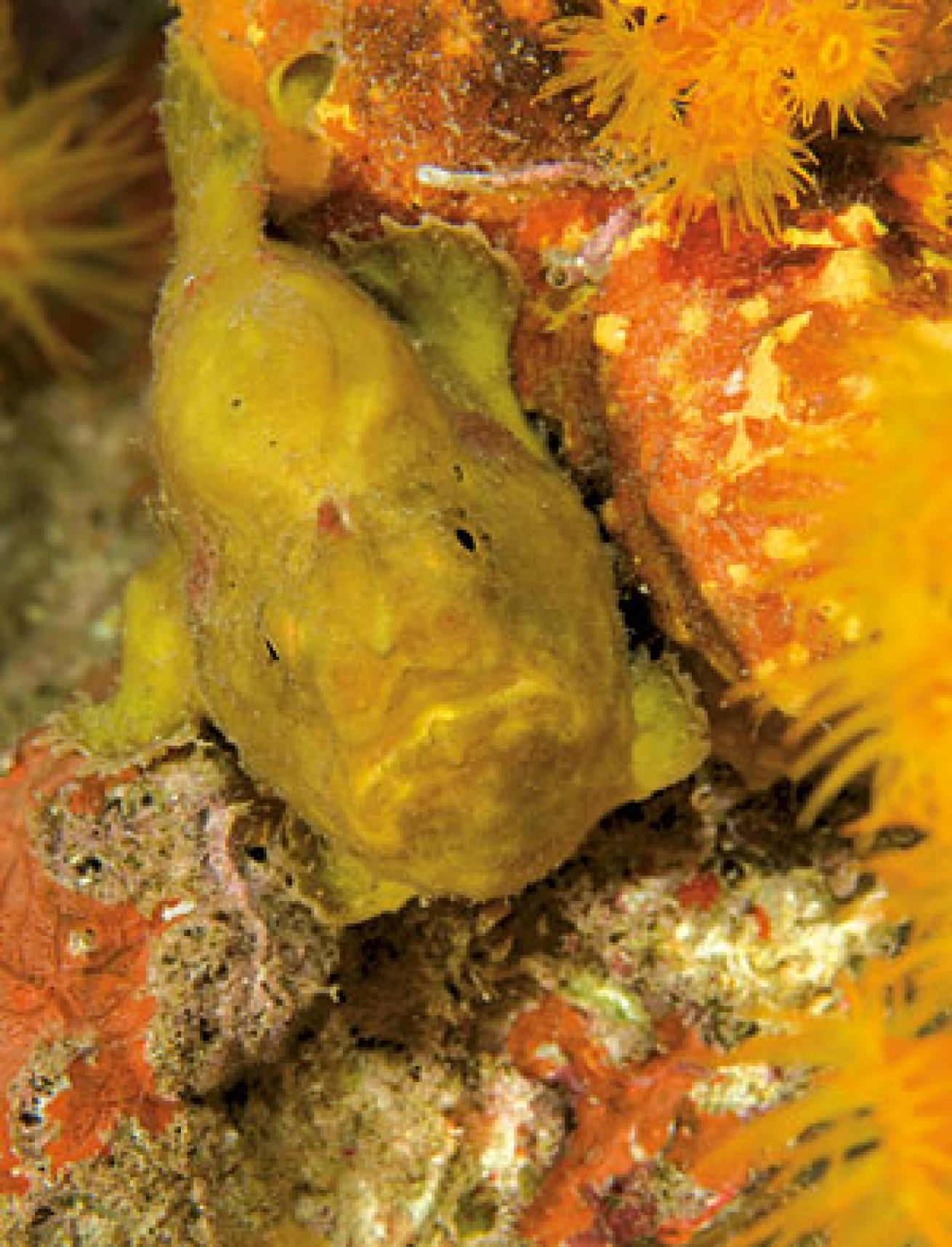
Steve SimonsenUnderwater photographers will delight in the macro treasures on Bonaire's reefs, like this longlure frogfish.
Klein Bonaire
The only way to dive Klein Bonaire, Bonaire's satellite island, is by boat. Most resorts offer morning or afternoon trips. Our first dive, at a site called Sampler, is a bit surreal. Halfway through the dive, I look up the coral slope toward the light, and the unlikely image of the Arizona desert comes to mind, with tube sponges replacing cactus, sea plumes filling in for tumbleweed and coral heads substituting for granite hillsides. True to its name, Sampler offers a variety of marine life — seahorses, massive turtles, delicate goldenspotted eels and massive schools of reef fish.
Knife is also a special site. It was reopened after being closed for a decade by the Bonaire National Parks Foundation to give the site a chance to recover from diving pressure. The rest has done the reef a lot of good, as its soft corals and tube sponges are in excellent shape, attracting thousands of juvenile fish, which surround me throughout the dive. Keep one eye on the open-water side of the dive, as manta rays, dolphins and sharks come in from the blue from time to time and turtle sightings are a regular occurrence.
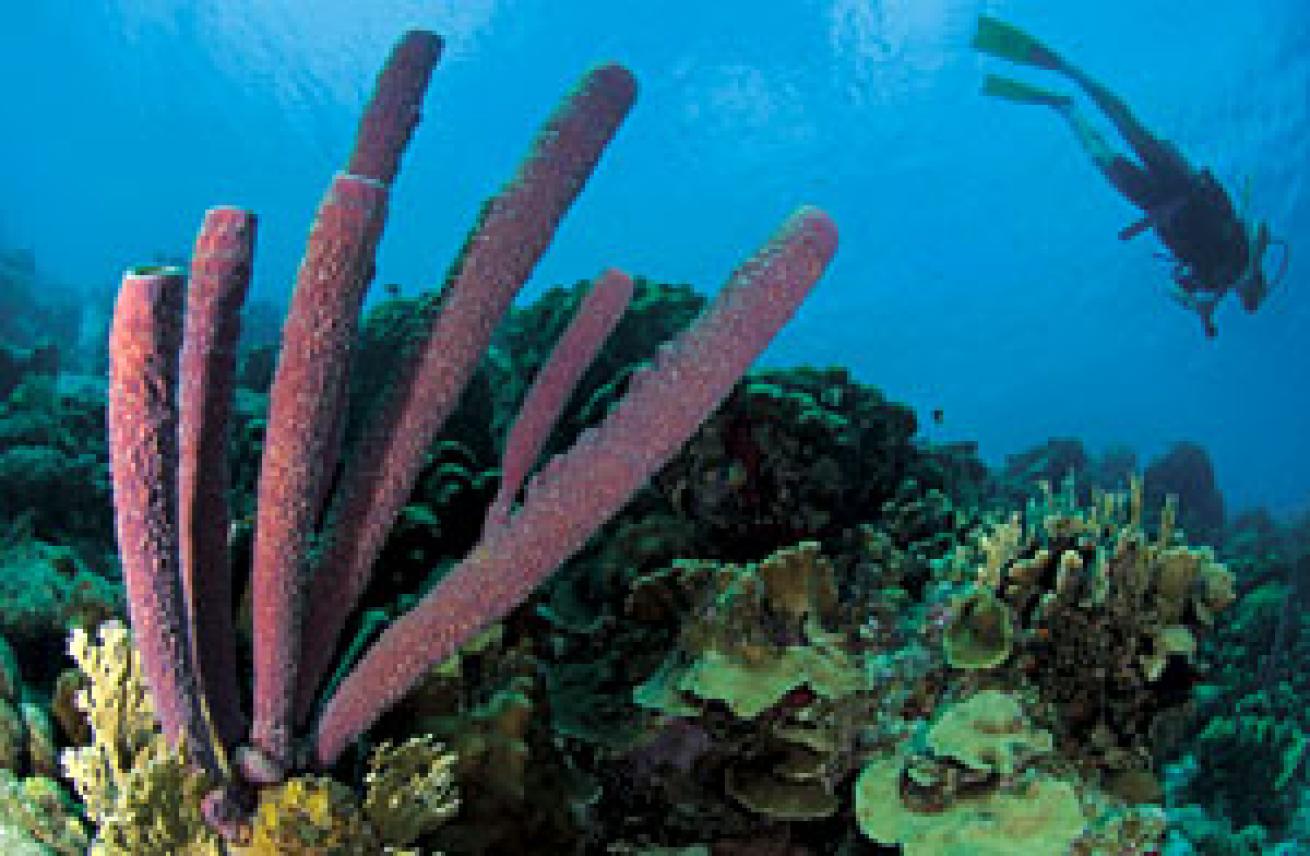
Steve SimonsenThese fllter-feeding tube sponges can be lavender, gray and brown.
At another recently reopened site here, Keepsake Reef, I can see the positive impact of the closure, as seahorses, goldenspotted eels, porcupinefish and French angelfish have returned, highlighting the usual selection of grunts and jacks.
Klein Bonaire also features a couple of nice drift dives off its eastern corner. At a site called Forest, we spend 50 minutes letting a current gently push us over to Southwest Corner, an adjacent site. We see turtles and some nice size barracuda along the way, but others report regular sightings of eagle rays and even the occasional dolphin.
The Wild Side
Until about 10 years ago, this area was virtually ignored by dive operators and divers because of a constant southeasterly wind blowing in, creating massive waves. Then, entrepreneur Larry Baillie bought a solid-hulled zodiac that could handle any waves the east side could create and opened Larry's Wildside Diving, still the area's only dive operation. The zodiac departs from a fishing dock on Bonaire's east side, about a 15-minute drive from Kralendijk. The adrenaline rush of riding the boat through the whitecaps is only the start of the thrills. That's because on our first dive, at Larry's Reef, we see eight large turtles and a half dozen large stingrays. Twice, like some kind of choreographed dance, the turtles swim by in the foreground, while the rays cross from the other direction.
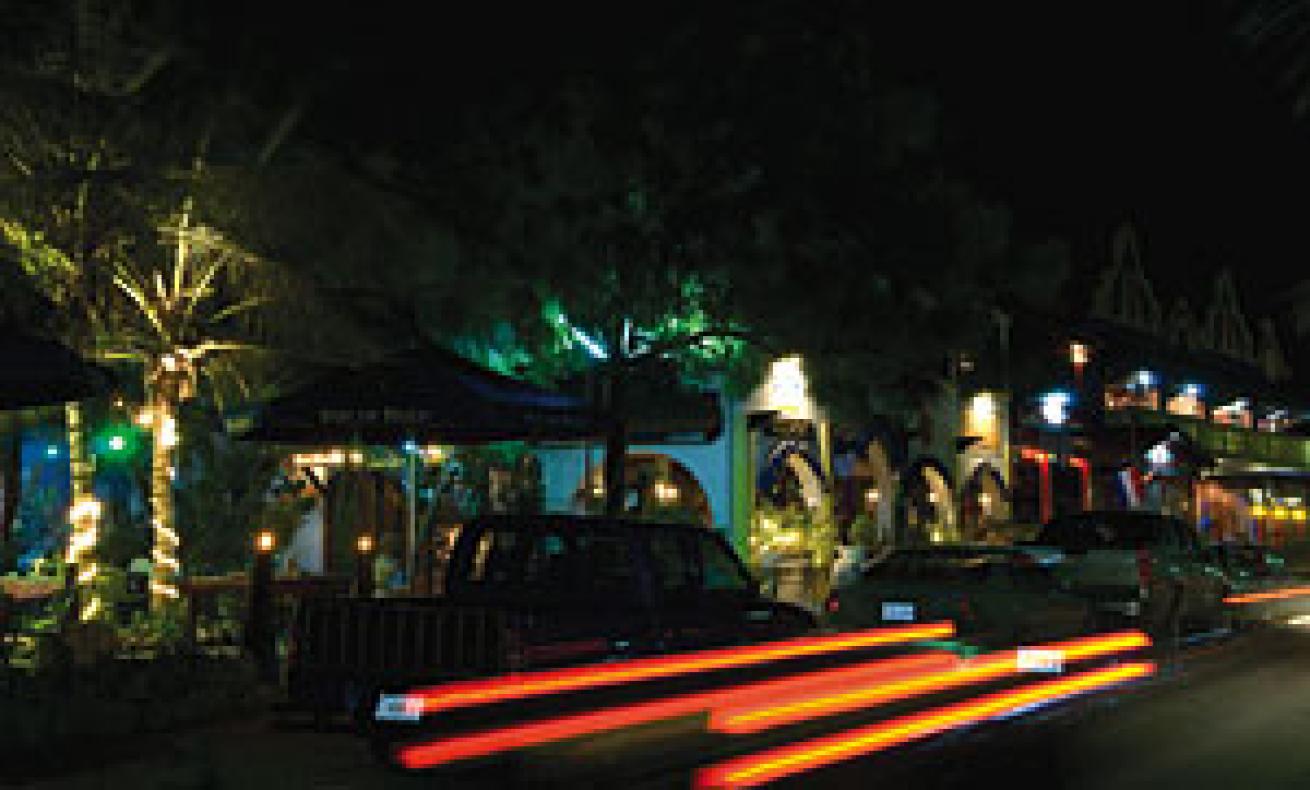
Steve SimonsenThe capital and main port on Bonaire, Kralendijk has a fun nightlife scene and lots of excellent restaurants.
Finally, we try out the White Hole. We make our way to what seems to be a large underwater amphitheater and swim to its far side, where more than a dozen large tarpon lazily swim about. If you hang in the water and let the gentle surge carry you, you'll get within a few feet of these seemingly plate mail-clad, medieval-looking fish. We also see several large green morays. But the most memorable moment comes as we pass one section of the reef where a school of thousands of blue chromis surges in and out. The small fish are swarming around the reef the way ants might after someone kicked over an anthill. Toward the end of the dive, a piece of seaweed that seems to have a little more control of its direction in the swell than others, comes into view. A closer look reveals a tiny seaweed blenny doing what it does best — blending into the scenery.
While this east-side dive experience is decidedly different from the rest of Bonaire diving, it's a testament to just how diverse the island's underwater offerings are. There's surprising variety from both the shore and from dive boats, but still, that's not the best part of Bonaire diving. It's being able to get up each morning and custom design your own diving experience. That's true diving freedom.
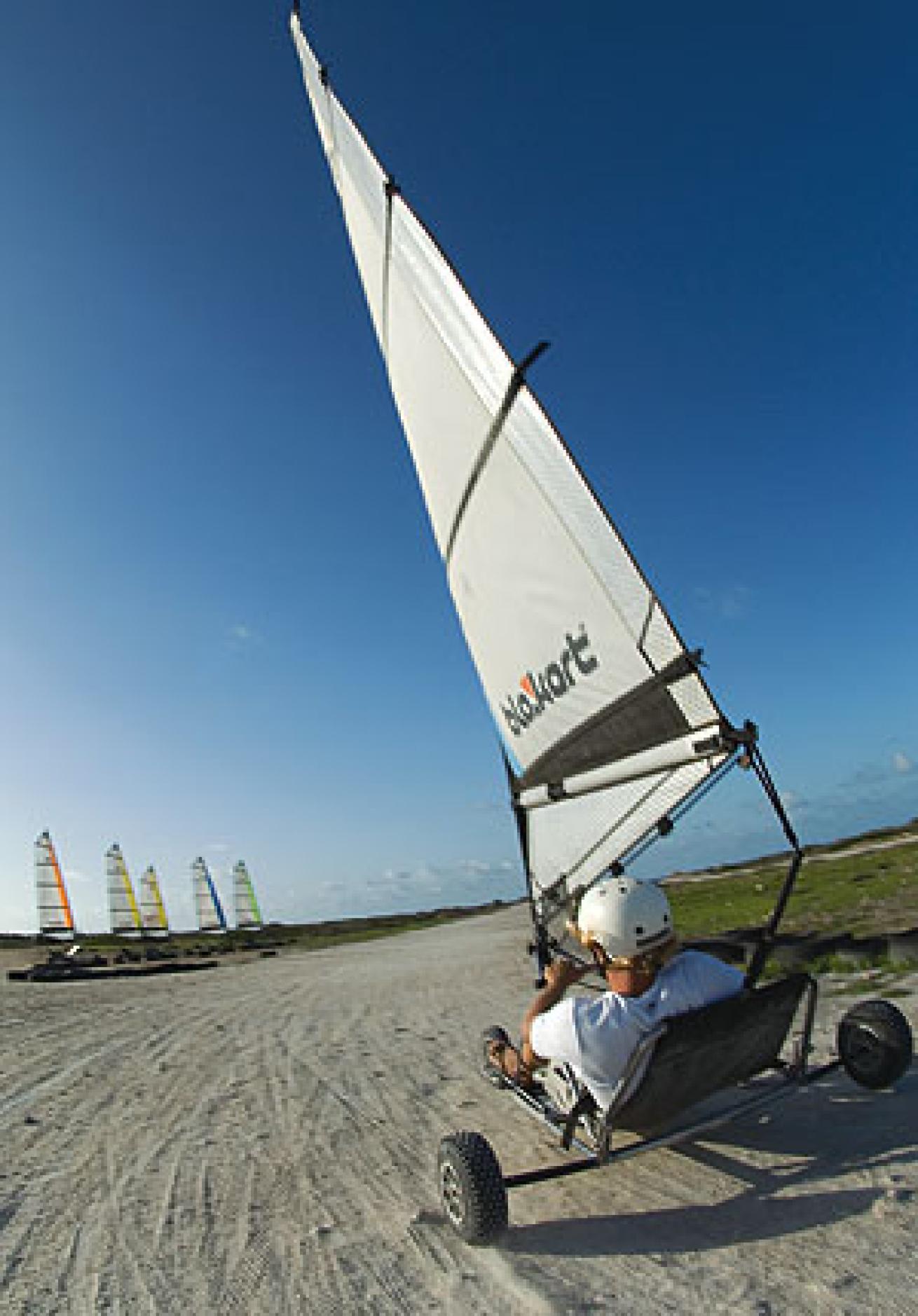
Steve SimonsenWhat to do with a steady tradewind and a flat track on a day you're not diving? Why, try blokarting, or landsailing!
A Model of Conservation: Bonaire National Marine Park
Bonaire's reefs are so healthy that countries around the globe try to emulate the island's conservation model, which started in the 1960s and encompasses all the waters around it and Klein Bonaire.
No matter how experienced or careful a diver you may be, you're legally bound to first earn it before setting fin in the water. STINAPA Bonaire, the foundation that oversees the marine park, requires every diver and snorkeler to complete an orientation session, that covers underwater rules and regulations. That also means making a checkout dive, supervised by a dive guide, ensuring that you're properly weighted and have good buoyancy skills. After checkout, you then purchase a marine park admission tag for $25. Here's the good news: All dive resorts and dive shops offer the orientations, checkouts and admission tags. Here's better news: The tags are good for a calendar year.
Recently, the Coral Restoration Foundation has been working in Bonaire to continue the island's legacy of conservation .
Diving The Town Pier
This site is considered one of the Caribbean's best night dives, and it doesn't take long to see why. Underneath this dock, brilliant golden cup corals and delicate purple tube sponges appear to be valiantly struggling to grow and cover unsightly mounds of industrial debris. Seahorses are hiding in the rubber tires and wreckage, hanging by their tails and camouflaging themselves as other pieces of debris. Massive pylons sprout from the ocean floor and shoot upward into the darkness, where canary yellow frogfish inhabit lofty perches. Spotted and golden-tailed moray eels have taken up residence in broken bits of concrete blocks. Despite its incongruous appearance, the Pier actually boasts a very healthy section of reef and abundant fish. But before you truck on down there, you must book this shore dive through your resort's dive shop at least 24 hours in advance (the shop must first get clearance from the harbor master) and be escorted at the site by a local dive guide.
Kralendijk: Bonaire's Charming Capital
Though it's hard to break away from the diving, it's worth paying a couple of visits to Kralendijk, Bonaire's capital. The town's heart takes up about three blocks and boasts historical buildings, a lovely waterfront boulevard, nice shopping and terrific restaurants and bars. To get started, pick up a free walking map of the town at the tourist office, on the corner of the main streets at Kaya Grandi 2 (tourismbonaire.com).
Kralendijk (pronounced Kraal-en-dike) is where Holland meets the Caribbean. The architecture — check out the Customs House and Old Fort close to Town Pier — is distinctly colonial Dutch overlaid with bright pastel colors for a true island flavor. Just walking along the main streets and browsing in the shops is a pleasant way to spend a morning or afternoon. With little car traffic, the whole town is pedestrian-friendly, and you can walk across it in about 20 minutes.
Name a cuisine and you'll probably find it in Kralendijk at one of its numerous restaurants and sidewalk cafes. You'll find places that feature traditional Caribbean dishes, but you can also sample Middle Eastern, Indonesian, Chinese, Mexican, French and Italian fare. For a complete list, check out infobonaire.com/restaurant.html.
Sunset is a great time to hit Kralendijk's waterfront at places like Karel's Beach Bar, which is built on a pier over the water, or City Cafe, located on the waterfront boulevard in the center of town. Both places really start to jump about 10 p.m., with music during the week and live bands on the weekend.
Off-gassing Options
Take a guided tour of Lac Bay, through the mangrove swamps. Pack a mask and snorkel and your guide can point out a nice swim-through tunnel under the mangrove trees. But watch where you step — scorpionfish do their best to look like rocks on the bottom.
Go "land sailing" in a three-wheeled, one-person aluminum cart, equipped with a sail and powered by wind. You use a hand-held rudder and rope to move your front wheel and maneuver fast or slow along a figure-eight track. After getting the hang of it, you can tear around the track at 30 mph, but it'll seem a lot faster.
landsailingbonaire.com
Guides lead small groups into the flooded limestone catacombs that riddle the island. Take a mask, snorkel and dive light. No technical expertise is required, and many resorts arrange trips for their guests.
Our Thanks
Buddy Dive Resort (buddydive.com) for hosting our team's stay.
InDepth
Dive Conditions: Water temps are in the mid-70s in winter; 80s in summer. Vis averages 50 to 60 feet.
Weather: 80s in winter; 90s in summer.
Money Matters: Currency is the Netherlands Antilles guilder (ANG), fixed at the exchange rate of 1.77 to the dollar for cash. You'll have to purchase a $25 marine park tag before you dive.
Tourism: Tourism Corporation Bonaire


